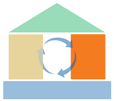The National Center on Quality Teaching and Learning uses a house to represent four integral elements of quality teaching and learning: engaging every day interactions with children (the foundation); choosing and implementing a strong curriculum (first pillar); using regular assessment of children's skills (second pillar), and individualized teaching (the roof). These elements--when connected with one another--form a single structure that fosters children's learning and development.
Selected Resources
- Framework for Effective Everyday Practice: Supporting School Readiness for All Children English [PDF, 326.70KB] En Español [PDF, 422KB]
- A Guide to Resources for Developing School Readiness Goals [PDF, 214KB]
- Program Level School Readiness Goals for Early Childhood Programs: Examples from the National Center on Early Childhood Development, Teaching, and Learning (NCECDTL) English [PDF, 151KB] En Español [PDF, 257KB]
Last Reviewed: December 2016
Last Updated: December 9, 2016




